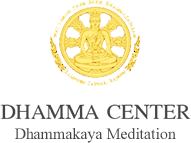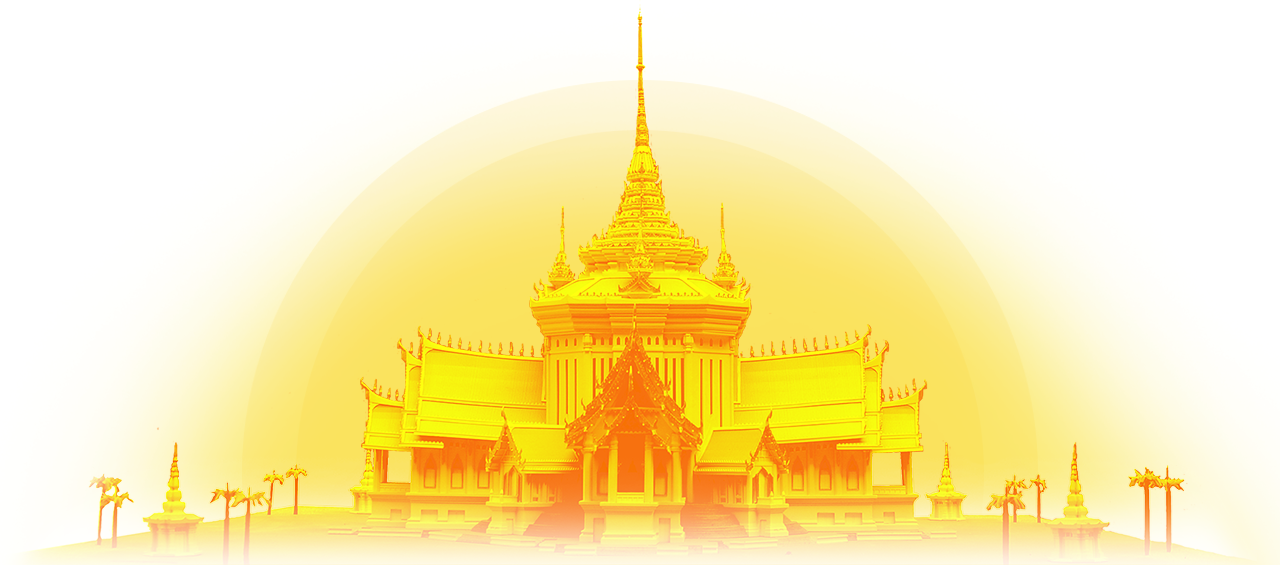- Home
- Monastery
- The Temple
Wat Luang Phor Sodh Dhammakayaram Temple is located on the beautifully landscaped campus of the Dhammakaya Buddhist Meditation Institute at kilometer 14 of the Damnoen Saduak - Bangpae Road, in Damnoen Saduak District of Rajburi Province, 93 kilometers from Bangkok. It encompasses 244 rais. The 74 rais surrounding the main monastery were registered in 1991 as Wat Luang Phor Sodh Dhammakayaram, in loving memory of Luang Phor Wat Paknam, Phra Mongkol Thepmuni (Sodh Candasaro). Here is a brief Profile:
Address: 109 Moo 7 Damnoen Saduak - Bangpae Road, Damnoen Saduak District, Rajburi Province, 70130.
Phone: (032) 745-180, Extension 220/191
Fax: (032) 745-170
Websites: www.dhammacenter.org
Email: somkuanyim@gmail.com
Dhammakaya Buddhist Meditation Institute
President: His Holiness Somdej Phra Maha Ratchamangkalajahn: Abbot, Wat Paknam Bhasicharoen & Sangha Council Member.
General Manager: Venerable Phrapidokkosol, Abbot, Wat Luang Phor Sodh Dhammakayaram & Coordinator, Provincial Meditation Institutes.
Financial and Property Management: Dhammakaya Buddhist Meditation Foundation.
Founding
- 21 May 1991: Registered as a Wat by the Ministry of Education and recognized by the Sangha body
- 2 May 1992: Consecrated as a Temple by His Holiness Somdej Phra Buddhaghosajahn, Former Abbot of Wat Sampaya, Bangkok, and Sangha Council Member
Recognized Excellence
- 1999: Recognized by the Sangha Body as Rajburi Provincial Pali Studies Center.
- 2004: Recognized by the Sangha Body as Rajburi Provincial Meditation Institute.
- 2005: Designated by the Sangha Body as an “Exemplary Development Temple with Noteworthy Success.”
- 2006: Established as Sangha Ecclesiastical Region 15 Academic Services Unit for Mahachulalongkornrajavidyalaya University (for four provinces).
- 2006: Wat Luang Phor Sodh Buddhist Meditation Institute established as an Associated Institution of the World Buddhist University.
- 2008: Elected the National Coordination Center of Provincial Meditation Institutes of Thailand.
- 2009: Established by the Sangha Body as the Center for Development of Virtues and Ethics for the Security of the Nation, Religion and Monarch.
Objectives
- To help humans rid themselves of suffering and penetrate Nirvana.
- To educate laity and monks to become knowledgeable, virtuous instructors spreading Lord Buddha’s teachings.
- To become a center of virtue supporting peace for all world beings.
- To become a pilgrimage center for the faithful: (1) Displaying sacred objects worthy of veneration and (2) Providing a clean, beautiful, serene environment for peaceful meditation and introspection.
- To faultlessly manage and preserve the sacred treasures and offerings of the faithful.
Wat Luang Phor Sodh Buddhist Meditation Institute (BMI), An Associated Institution of the World Buddhist University
Wat Luang Phor Sodh Dhammakayaram is a Theravada Buddhist Temple in Damnoen Saduak District of Rajburi Province, Thailand, two hours from Bangkok. The campus is a beautifully landscaped 33-acre park, featuring a lake and rivers surrounded by grass and trees. Temple buildings are vividly white, to signify purity. There are generally about 100 monks and 60 novices in residence, joined continually by hundreds of short-term participants in the Wat’s constant stream of varied educational programs. It is lovingly named for the Most Venerable Phra Mongkol-thepmuni, Luang Phor Wat Paknam, whose given name was Sodh. The Venerable Abbot, Phra Thepyanmongkol is one of Thailand’s most eminent Meditation Masters and Buddhist Scholars, now serving as President of National Coordinator of Provincial Meditation Institutes throughout Thailand. He initiated retreats at the forerunner institute in 1982 and personally established the temple which was formally registered in 1991.
International outreach began when the Wat luang Phor Sodh Buddhist Meditation Institute (BMI) was approved as an Associated Institution of the World Buddhist University on April 19th, 2006, during the 23rd, General Conference of the World Fellowship of Buddhists at Fo Guang Monastery, Kaohsiung, Taiwan Since then.
Its objective is to extend Buddhist meditation to individuals worldwide caught up in the pressure and emptiness of modern consumerism, in order to foster personal serenity, social harmony, and global peace.
Success
BMI has taught a total of 400 meditators from over 30 countries, mostly from Europe and the Americas. Very few were monks. Over half were women. Many came via volunteer exchange programs (Greenway, Global Service Corps & Imaginations), but increasingly they are sent by former participants or arrive on their own.
Essentially all participants found inner peace. Over half (53%) of those who stayed more than one day meditated to absorption or jhana, seeing and becoming some refined inner body. Four out of ten (40%) meditated to transcendence, seeing and becoming some Dhammakaya; and one out of four (24%) meditated to personally visiting and experiencing Nirvana temporarily. Our teaching has improved over the years. Now, two-out-of-three become a refined body; half transcend to Dhammakaya; and four-out-of-ten visit Nirvana. Starting this year, some participants who cannot experience Nirvana are being taught directly by their Noble Disciple Dhammakayas. Thus, they can carry their teacher with them for the rest of their lives. Most participants rate the experience very or extremely valuable. For many, it opened new worlds.
The National Coordination Center of Provincial Meditation Institutes at Wat Luang Phor Sodh Dhammakayaram 2008-2014
The National Coordination Center of Provincial Meditation Institutes is an organization established on 24 April 2008 to serve the Sangha Body, with the following objectives:
- To support the Sangha Body’s Provincial Meditation Centers to administer Buddhist Education effectively,
- To cooperate with Provincial Meditation Centers to teach meditation to the same high standard for all people at all levels, especially for the youth, for the benefit, peace and stability of the Thai Society, Nation, Buddhism and Monarchy.
- To cooperate with the Chiefs of the Sangha Regions and Directors of the Provincial Meditation Centers to raise academic training techniques to the same high national standard.
- To assist Provincial Meditation Centers with academic scholarship,
- To support the Sangha in stabilizing, protecting and developing Buddhism under the rules of the Discipline, the Law and the Sangha Rules.
The National Coordination Center of Provincial Meditation Institutes was founded on 24 April 2008 at a conference and practicum organized by the National Office of Buddhism, held at Wat Yanawa, Bangkok, and led by Phra Brahmavajirayan. At this meeting, 338 Directors of Meditation Centers out of 400 across the country voted for the establishment of the National Coordination Center of Provincial Meditation Institutes and they chose Phra Thepyanmongkol as the President. They also chose Phra Brahmavajirayan, Phra Bhramamolee and Phra Dhammapariyatveti as Advisory Directors. On 12 May 2008, the National Coordination Center of Provincial Meditation Institutes was recognized by the Sangha Body. Again, on April 2011, Phra Thepyanmongkol was elected to serve his second term as president.
On 31 October 2008, Somdej Phra Maha Ratchamangkalajahn led the fourth conference held at Wat Luang Phor Sodh Dhammakayaram and the Committee Members agreed to invite Somdej Phra Maha Ratchamangkalajahn as President of the Board and each Sangha Region Chief as the President of the Provincial Meditation Centers located on their regions. All members also agreed that the National Coordination Center of Provincial Meditation Institutes extends to both Mahanikaya and Dhammayut sects.
In the same year, the committee members agreed to publish the Study Guide for Right Practice of the Three Trainings (Trisikkha), based on Lord Buddha’s Four Foundations of Mindfulness and the Commentaries from the Path of Purification (Visuddhimagga), plus the Three Aspects of Nirvana, which is an Appendix. This proposal was presented to the conference, led by Somdej Phra Maha Ratchamangkalajahn, and it was agreed to publish this book and distribute it to all Meditation Centers. The book has been translated and edited in English by Phra Khru Baitika Dr. Barton Yanathiro, Phra Natpakanan Gunanggalo, and Phra William Akapunyo of the Wat Luang Phor Sodh Buddhist Meditation Institute and Mr. Potprecha Cholvijarn. Now, the book is downloadable in eBooks’ section.




